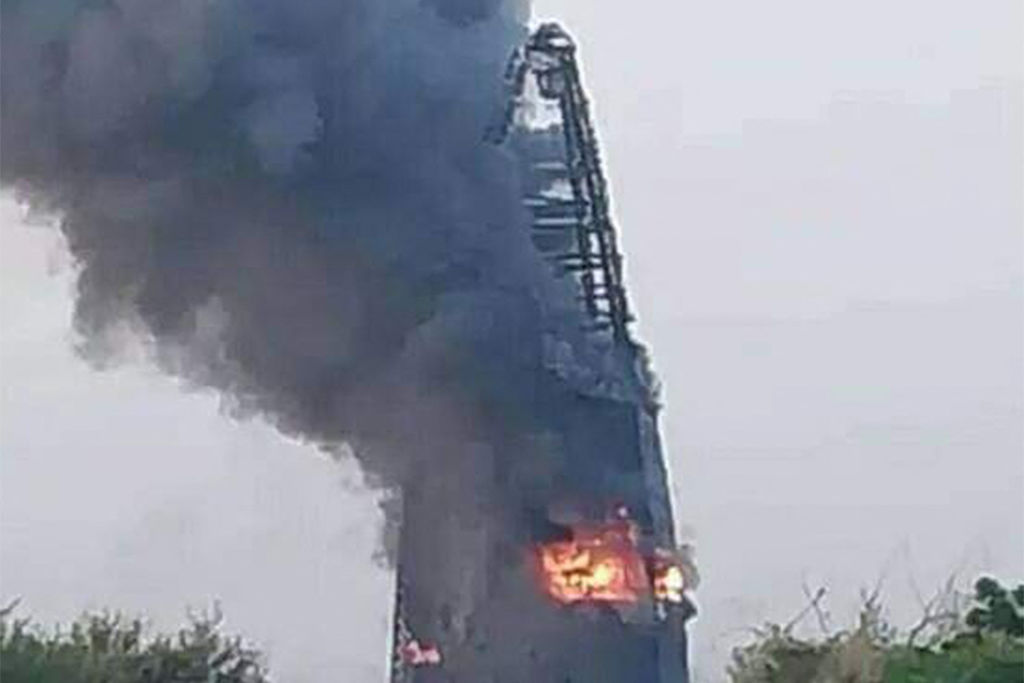Fighting Reduces Khartoum Landmarks to Rubble
ADF STAFF
The tapering sides and glass façade of Khartoum’s Greater Nile Petroleum Company evoke a jet flame of gas burning in Sudan’s oil fields. Its location at the confluence of the White and Blue Nile made the tower an eye-catching landmark and a symbol of the country.
“Since its construction, there was hardly a photo, painting or a graphic design piece about Khartoum that did not include this building in its skyline,” architect Arwa Ahmed told The Conversation in a recent interview.
The tower and the larger Al Sunut project it belonged to presented “a vision for new hope for Sudan,” Ahmed said.
In September, the 18-floor tower became a different kind of symbol for Sudan when it caught fire amid intense fighting between the Sudanese Armed Forces (SAF) and Rapid Support Forces (RSF). Videos posted online showed thick black smoke billowing from the building’s shattered windows.
Since war broke out between the SAF and RSF in mid-April, the conflict has devastated Khartoum and its sister city, Omdurman. The combination of street fighting by the RSF and heavy artillery use by the SAF has laid waste to large chunks of the capital region.
“There is a total destruction of infrastructure to make sure that this country is unable to stand up on its feet anytime soon,” Khartoum resident and analyst Reem Abbas told the International Crisis Group’s “The Horn” podcast, speaking about RSF actions in the city. “What’s happening is difficult to understand.”
What began in the area surrounding Khartoum International Airport and the SAF headquarters in central Khartoum has now spread across the entire region of more than 5 million people. Fighting has destroyed factories, libraries, schools, power installations, water pumping facilities and telecommunications towers.
“The basic services of life are apparently deliberately targeted, forcing people to flee,” Osman told The Conversation in an interview.
Millions of capital-region residents have done exactly that, joining the millions of other Sudanese who have fled to safety in other provinces or other countries.
“This city is now a ghost town of abandoned homes, snipers and dead bodies on the streets,” architect Amira Osman wrote in an essay for The Conversation. “The militia are occupying most of it, rendering residents human shields as the army attacks them from the air.”
Along with high-profile properties such as the Greater Nile Petroleum tower and the Sudan National Museum, thousands of private homes and apartment blocks have also been destroyed, often as SAF forces pursued RSF fighters hiding within them.
“The destruction of major buildings exposes the scale of the conflict’s impact on civilians and the country’s infrastructure. It visualizes the future of the city if the war continues,” architect Akram Elkhalifa told The Conversation.
The Sudan War Monitor has reported on the destruction of a mosque and thousands of private homes in Omdurman during SAF airstrikes against RSF targets. SAF attacks on Omdurman’s Melga market in July killed dozens of traders and truck drivers. An attack in September destroyed Khartoum’s Qouro market, killing 60 people.
Experts say the fighting between the SAF, led by Gen. Abdel Fattah al-Burhan, and the RSF, headed by a general commonly known as Hemedti, has become a winner-take-all battle for control of Sudan and the kleptocratic economy that underpins it, a legacy of former dictator Omar al-Bashir.
For that reason, the fighting is unlikely to end anytime soon, analyst Samah Salman told ADF.
“They both see themselves succeeding al-Bashir as the next self-appointed autocrat,” Salman said.
The destruction of Khartoum and Omdurman is about more than simply the loss of buildings. For residents of the capital region, the destruction has wiped out personal income, educational opportunities, and decades of accumulated family wealth.
“So as the city continues to be destroyed, one must also wonder about the loss of everything that people have acquired over their lifetimes and what the consequences will be,” Osman wrote. “It means the loss of hope in a dream of what could have been.”


Comments are closed.